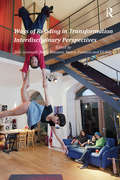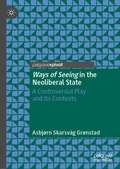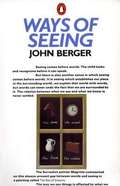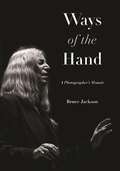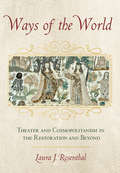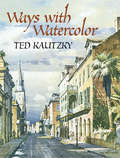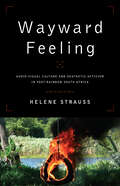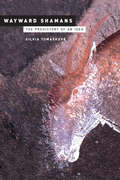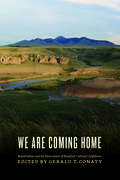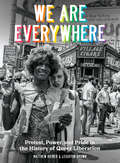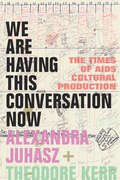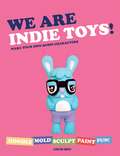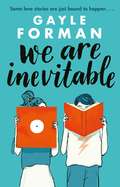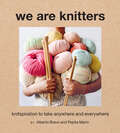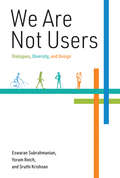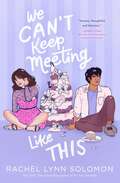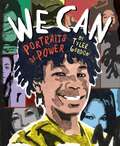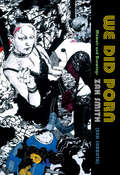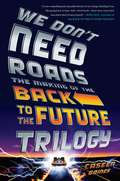- Table View
- List View
Ways of Residing in Transformation: Interdisciplinary Perspectives
by Sten Gromark Mervi Ilmonen Katrin Paadam Eli StøaProfound transformations in residential practices are emerging in Europe as well as throughout the urban world. They can be observed in the unfolding diversity of residential architecture and spatially restructured cities. The complexity of urban and societal processes behind these changes requires new research approaches in order to fully grasp the significant changes in citizens lifestyles, their residential preferences, capacities and future opportunities for implementing resilient residential practices. The international case studies in this book examine why ways of residing have changed as well as the meaning and the significance of the social, economic, political, cultural and symbolic contexts. The volume brings together an interdisciplinary range of perspectives to reflect specifically upon the dynamic exchange between evolving ways of residing and professional practices in the fields of architecture and design, planning, policy-making, facilities management, property and market. In doing so, it provides a resourceful basis for further inquiries seeking an understanding of ways of residing in transformation as a reflection of diversifying residential cultures. This book will offer insights of interest to academics, policy-makers and professionals as well as students of urban studies, sociology, architecture, housing, planning, business and economics, engineering and facilities management.
Ways of Seeing in the Neoliberal State: A Controversial Play and Its Contexts
by Asbjørn Skarsvåg GrønstadThis book focuses on the theme of counter-surveillance in art through a multi-faceted engagement with the highly controversial Norwegian play Ways of Seeing. Denounced by the prime minister and subject to a police investigation, the play gained notoriety when it featured footage showing the homes of the country’s financial and political elite as part of its scenography. The book provides a thorough consideration of the work’s reception context before elucidating its relation to the politics of neoliberalism. What is foregrounded in this analysis are, first, the use of an aesthetics of sousveillance to visualize the material infrastructure of racism and right-wing populism, second, the tangled interrelations of art and law, third, questions of censorship and artistic freedom, and fourth, the promotion of an alternative mode of political governance – grounded in feminism and ecological awareness – through the example of the Rojava experiment.
Ways of Seeing: Based on the BBC Television Series with John Berger
by John BergerContains seven essays. Three of them use only pictures. Examines the relationship between what we see and what we know.
Ways of the Hand: A Photographer's Memoir (Excelsior Editions)
by Bruce JacksonHonorable Mention, for the 2022 Foreword INDIES Book of the Year Award in the Photography CategoryRocker Rod Stewart, Jackson says, had it wrong when he titled his breakthrough album Every Picture Tells a Story. Pictures don't tell stories—but many of them call to mind stories or have stories about their making.Throughout his sixty-year career as folklorist, ethnographer, criminologist, filmmaker, and journalist, Bruce Jackson has taken photographs of family, friends, people he worked with, people he studied, and people he encountered. Ways of the Hand includes 112 of his favorite portraits, portraits in which the hands are often as expressive as the faces. In six sections, Jackson shares photographs of notable musicians, political figures, activists, actors, artists, and writers. These portraits are accompanied by stories of how and where they were taken and the stories they invoke or reflect. The result is a stunning visual and narrative memoir of a lifetime of encounters.
Ways of the World: Theater and Cosmopolitanism in the Restoration and Beyond
by Laura J. RosenthalWays of the World explores cosmopolitanism as it emerged during the Restoration and the role theater played in both memorializing and satirizing its implications and consequences. Rooted in the Stuart ambition to raise the status of England through two crucial investments—global traffic, including the slave trade, and cultural sophistication—this intensified global orientation led to the creation of global mercantile networks and to the rise of an urban British elite who drank Ethiopian coffee out of Asian porcelain at Ottoman-inspired coffeehouses. Restoration drama exposed cosmopolitanism's most embarrassing and troubling aspects, with such writers as Joseph Addison, Aphra Behn, John Dryden, and William Wycherley dramatizing the emotional and ethical dilemmas that imperial and commercial expansion brought to light.Altering standard narratives about Restoration drama, Laura J. Rosenthal shows how the reinvention of theater in this period—including technical innovations and the introduction of female performers—helped make possible performances that held the actions of the nation up for scrutiny, simultaneously indulging and ridiculing the violence and exploitation being perpetuated. In doing so, Ways of the World reveals an otherwise elusive consistency between Restoration genres (comedy, tragedy, heroic plays, and tragicomedy), disrupts conventional understandings of the rise and reception of early capitalism, and offers a fresh perspective on theatrical culture in the context of the shifting political realities of seventeenth- and eighteenth-century Britain.
Ways with Watercolor
by Ted KautzkyIn simple, direct language, accompanied by purposeful illustrations, teacher and master watercolorist Ted Kautzky shows beginners how to handle the medium. Widely regarded as the author's best work, the book discusses color pigments, paper, and other supplies; washes, strokes, and the use of accessories for special effects. Important chapters follow on the characteristics and techniques of handling limited and full palettes. Valuable instructions on composition and related subjects are interwoven throughout the text. In addition to many demonstrations, there is also challenging practice material.
Wayside Teaching: Connecting with Students to Support Learning
by Sara Davis PowellWayside teaching is about intentionally practicing what educators do every day in perhaps unintentional ways: relate to students. This practical, research-based guide illustrates how wayside teaching—the informal curriculum, implicit instruction, and mentoring that happens in sometimes unintentional ways—can be intentionally practiced across grade levels to enhance learning and boost student outcomes. Through a framework focused on attitudes, approaches, and actions, and using vignettes that illuminate wayside teaching in action, Sara Davis Powell demonstrates how reaching out to students in formal and informal situations helps create a culture of belonging and safety that strengthens a student’s self-image, confidence, resiliency, and cognitive processes. Offering invaluable resources, including student surveys for learning more about your students and an annotated booklist for promoting acceptance and compassion, Wayside Teaching reflects the powerful influence that teachers’ actions can have on their students’ academic and personal lives.
Wayward Feeling: Audio-Visual Culture and Aesthetic Activism in Post-Rainbow South Africa (African & Diasporic Cultural Studies)
by Helene StraussInventive new methods of audio-visual mediation and aesthetic activism have been giving shape, since at least the mid-2000s, to feelings of despair, disappointment, and rage at the injustice that South Africa’s colonial and apartheid histories continue to trail in their wake. Wayward Feeling reveals how racism, sexism, and other forms of structural disenfranchisement have continued to assert themselves in affective terms, and how these terms have been recast in spaces both public and intimate in "post-rainbow" times. Helene Strauss argues that the tension between aspiration and achievability has yielded modes of feeling that increasingly disrupt the thrall of post-apartheid nation-building and reconciliation myths, even as wide-spread attachment to the utopian ideals of the anti-apartheid struggle continues to shape dissenting political organising and cultural production. Drawing on a variety of audio-visual forms – including video installations, conceptual artwork, documentary film, live art, and sonic installations – Wayward Feeling examines some of the affective resources that people in contemporary South Africa have been drawing on to make difficult lives more bearable.
Wayward Shamans
by Silvia TomáškováWayward Shamans tells the story of an idea that humanity's first expression of art, religion and creativity found form in the figure of a proto-priest known as a shaman. Tracing this classic category of the history of anthropology back to the emergence of the term in Siberia, the work follows the trajectory of European knowledge about the continent's eastern frontier. The ethnographic record left by German natural historians engaged in the Russian colonial expansion project in the 18th century includes a range of shamanic practitioners, varied by gender and age. Later accounts by exiled Russian revolutionaries noted transgendered shamans. This variation vanished, however, in the translation of shamanism into archaeology theory, where a male sorcerer emerged as the key agent of prehistoric art. More recent efforts to provide a universal shamanic explanation for rock art via South Africa and neurobiology likewise gloss over historical evidence of diversity. By contrast this book argues for recognizing indeterminacy in the categories we use, and reopening them by recalling their complex history.
We Are Coming Home: Repatriation and the Restoration of Blackfoot Cultural Confidence
by Allan Pard Chris Mchugh Frank Weasel Head Gerald T. Conaty Herman Yellow Old Woman Jerry Potts John W. Ives Robert R. JanesIn 1990, Gerald Conaty was hired as senior curator of ethnology at the Glenbow Museum, with the particular mandate of improving the museum’s relationship with Aboriginal communities. That same year, the Glenbow had taken its first tentative steps toward repatriation by returning sacred objects to First Nations’ peoples. These efforts drew harsh criticism from members of the provincial government. Was it not the museum’s primary legal, ethical, and fiduciary responsibility to ensure the physical preservation of its collections? Would the return of a sacred bundle to ceremonial use not alter and diminish its historical worth and its value to the larger society? Undaunted by such criticism, Conaty oversaw the return of more than fifty medicine bundles to Blackfoot and Cree communities between the years of 1990 and 2000, at which time the First Nations Sacred Ceremonial Objects Repatriation Act (FNSCORA)—still the only repatriation legislation in Canada—was passed. “Repatriation,” he wrote, “is a vital component in the creation of an equitable, diverse, and respectful society.” We Are Coming Home is the story of the highly complex process of repatriation as described by those intimately involved in the work, notably the Piikuni, Siksika, and Kainai elders who provided essential oversight and guidance. We also hear from the Glenbow Museum’s president and CEO at the time and from an archaeologist then employed at the Provincial Museum of Alberta who provides an insider’s view of the drafting of FNSCORA. These accounts are framed by Conaty’s reflections on the impact of museums on First Nations, on the history and culture of the Niitsitapi, or Blackfoot, and on the path forward. With Conaty’s passing in August of 2013, this book is also a tribute to his enduring relationships with the Blackfoot, to his rich and exemplary career, and to his commitment to innovation and mindful museum practice.
We Are Everywhere: Protest, Power, and Pride in the History of Queer Liberation
by Matthew Riemer Leighton BrownHave pride in history. A rich and sweeping photographic history of the Queer Liberation Movement, from the creators and curators of the massively popular Instagram account @lgbt_history, released in time for the 50th anniversary of the Stonewall Riots. <P><P>Through the lenses of protest, power, and pride, We Are Everywhere is an essential and empowering introduction to the history of the fight for queer liberation. Combining exhaustively researched narrative with meticulously curated photographs, the book traces queer activism from its roots in late-nineteenth-century Europe--long before the pivotal Stonewall Riots of 1969--to the gender warriors leading the charge today. Featuring more than 300 images from more than seventy photographers and twenty archives, this inclusive and intersectional book enables us to truly see queer history unlike anything before, with glimpses of activism in the decades preceding and following Stonewall, family life, marches, protests, celebrations, mourning, and Pride. <P><P>By challenging many of the assumptions that dominate mainstream LGBTQ+ history, We Are Everywhere shows readers how they can--and must--honor the queer past in order to shape our liberated future.
We Are Having This Conversation Now: The Times of AIDS Cultural Production
by Alexandra Juhasz Theodore KerrWe Are Having This Conversation Now offers a history, present, and future of AIDS through thirteen short conversations between Alexandra Juhasz and Theodore Kerr, scholars deeply embedded in HIV responses. They establish multiple timelines of the epidemic, offering six foundational periodizations of AIDS culture, tracing how attention to the crisis has waxed and waned from the 1980s to the present. They begin the book with a 1990 educational video produced by a Black health collective, using it to consider organizing intersectionally, theories of videotape, empowerment movements, and memorialization. This video is one of many powerful yet overlooked objects that the pair focus on through conversation to understand HIV across time. Along the way, they share their own artwork, activism, and stories of the epidemic. Their conversations illuminate the vital role personal experience, community, cultural production, and connection play in the creation of AIDS-related knowledge, archives, and social change. Throughout, Juhasz and Kerr invite readers to reflect and find ways to engage in their own AIDS-related culture and conversation.
We Are Indie Toys
by Louis BouThe indie world is producing extraordinary toy characters but little is known about the designers creating them or the processes used to make them. We Are Indie Toys! profiles the most interesting toymakers and reveals how they turn their unique ideas into one-of-a-kind collectibles.
We Are Inevitable
by Gayle FormanA heartbreaking story about finding yourself and your people, from the bestselling author of If I Stay, a major film starring Chloë Grace Moretz. For fans of The Perks of Being a Wallflower, John Green and Nick and Norah&’s Infinite Playlist.'I got this whole-body feeling . . . it was like a message from future me to present me, telling me that in some way we weren&’t just bound to happen, that we had, in some sense, already happened. It felt . . . inevitable.' So far, the inevitable hasn&’t worked out so well for Aaron Stein. While his friends have gone to college and moved on with their lives, Aaron&’s been left behind in the Cascade Mountains of Washington State, running a failing bookshop with his dad, Ira. What he needs is a lucky break, the good kind of inevitable. And then he meets Hannah. Incredible Hannah – magical, musical, brave and clever. Could she be the answer? And could they – their relationship, their meeting – possibly be the inevitable Aaron&’s been waiting for?
We Are Knitters: Knitspiration to Take Anywhere and Everywhere
by Alberto Bravo Pepita MartinFashionable patterns, fabulous photos from around the world, and DIY inspiration for beginning knitters and beyond. We Are Knitters has created a worldwide community more than a million strong—and now they have compiled a book that provides not only patterns for hats, sweaters, blankets, tank tops, and more, but gorgeous photography from a variety of locations, including New York, Paris, Marrakech, Cartagena, and beyond, and plenty of sophisticated, stylish inspiration. The book is welcoming to beginners, with a section on basics and lots of encouragement. For needlecrafters at all levels and those who care about sustainable slow fashion, We Are Knitters is an ideal companion.
We Are Made of Stories: Self-Taught Artists in the Robson Family Collection
by Leslie UmbergerA richly illustrated history of self-taught artists and how they changed American artArtists without formal training, who learned from family, community, and personal journeys, have long been a presence in American art. But it wasn’t until the 1980s, with the help of trailblazing advocates, that the collective force of their creative vision and bold self-definition permanently changed the mainstream art world. In We Are Made of Stories, Leslie Umberger traces the rise of self-taught artists in the twentieth century and examines how, despite wide-ranging societal, racial, and gender-based obstacles, they redefined who could be rightfully seen as an artist and revealed a much more diverse community of American makers.Lavishly illustrated throughout, We Are Made of Stories features more than one hundred drawings, paintings, and sculptures, ranging from the narrative to the abstract, by forty-three artists—including James Castle, Thornton Dial, William Edmondson, Howard Finster, Bessie Harvey, Dan Miller, Sister Gertrude Morgan, the Philadelphia Wireman, Nellie Mae Rowe, Judith Scott, and Bill Traylor. The book centralizes the personal stories behind the art, and explores enduring themes, including self-definition, cultural heritage, struggle and joy, and inequity and achievement. At the same time, it offers a sweeping history of self-taught artists, the critical debates surrounding their art, and how museums have gradually diversified their collections across lines of race, gender, class, and ability.Recasting American art history to embrace artists who have been excluded for too long, We Are Made of Stories vividly captures the power of art to show us the world through the eyes of another.Published in association with the Smithsonian American Art MuseumExhibition ScheduleSmithsonian American Art Museum, Washington, DCJuly 1, 2022–March 26, 2023
We Are Not Users: Dialogues, Diversity, and Design
by Yoram Reich Eswaran Subrahmanian Sruthi KrishnanA call to reclaim and rethink the field of designing as a liberal art where diverse voices come together to shape the material world. We live in a material world of designed artifacts, both digital and analog. We think of ourselves as users; the platforms, devices, or objects provide a service that we can use. But is this really the case? We Are Not Users argues that people cannot be reduced to the entity called “user”; we are not homogenous but diverse. That buzz of dissonance that we hear reflects the difficulty of condensing our diversity into “one size fits all.” This book proposes that a new understanding of design could resolve that dissonance, and issues a call to reclaim and rethink the field of designing as a liberal art where diverse voices come together to shape the material world. The authors envision designing as a dialogue, simultaneously about the individual and the social—an act enriched by diversity of both disciplines and perspectives.The book presents the building blocks of a language that can conceive designing in all its richness, with relevance for both theory and practice. It introduces a theoretical model, terminology, examples, and a framework for bringing together the social, cultural, and political aspects of designing. It will be essential reading for design theorists and for designers in areas ranging from architecture to software design and policymaking.
We Are the Mutants: The Battle for Hollywood from Rosemary's Baby to Lethal Weapon
by Kelly Roberts, Michael Grasso and Richard McKennaAn offbeat odyssey through the most daring and disruptive phase of American cinema since the advent of sound — during the most transformative and tumultuous period of American history since the Civil War.We Are the Mutants is a critical reassessment of what is arguably the most discussed and beloved stretch of movies in Hollywood history.Documenting the period between the arrival of US combat troops in Vietnam and the end of President Ronald Reagan&’s second term, it forgoes the usual and restrictive exemplars of &“auteur cinema,&” and instead focuses on an eclectic selection of films and genres — horror, documentary, disaster, vigilante action, neo-noir, post-apocalyptic sci-fi — to track this period's tumultuous transformation in American life, culture, and politics.Covering everything from Rosemary&’s Baby and Enter the Dragon to Escape from New York and Fatal Attraction, and from manufactured blockbusters and studio sleepers to forgotten Bs and cult classics, We Are the Mutants re-writes the history of modern American cinema, and in doing so, the history of America itself.
We Be Big: The Mostly True Story of How Two Kids from Calhoun County, Alabama, Became Rick & Bubba
by Rick Burgess Don Keith Bill "Bubba" BusseyThe New York Times–bestselling authors tell the inspiring story of their rise to talk radio fame—and the ups and downs of their lives off the air. If you’ve ever started your day with Rick and Bubba, you know the unmistakable drawl of those two crazy Alabama boys. What you may not know is that they almost weren’t “Rick and Bubba.”From their glory days of homemade “radio stations,” youthful athletic ambition, and redneck Shakespearean monologues, Rick and Bubba spent decades working out the personalities you hear today on their syndicated morning talk show. Born in a little studio behind a skating rink, The Rick & Bubba Show filled the airwaves with a voice never before heard on morning radio.We Be Big follows the winding road that led Rick Burgess and Bill “Bubba” Bussey onto the right path after years of missing the off-ramp. Find out how what started as a comedy routine evolved into a genuine conversation that more than 3.5 million people listen in on each week; and learn all the stories behind Rick and Bubba’s famous on-air hijinks, times of uncertainty, and unwavering faith in the face of tragedy.Meet the two “sexiest fat men alive,” and experience the hilarity and heartbreak of their unforgettable story.
We Can't Keep Meeting Like This
by Rachel Lynn SolomonA wedding harpist disillusioned with love and a hopeless romantic cater-waiter flirt and fight their way through a summer of weddings in this effervescent romantic comedy from the acclaimed author of Today Tonight Tomorrow.Quinn Berkowitz and Tarek Mansour&’s families have been in business together for years: Quinn&’s parents are wedding planners, and Tarek&’s own a catering company. At the end of last summer, Quinn confessed her crush on him in the form of a rambling email—and then he left for college without a response. Quinn has been dreading seeing him again almost as much as she dreads another summer playing the harp for her parents&’ weddings. When he shows up at the first wedding of the summer, looking cuter than ever after a year apart, they clash immediately. Tarek&’s always loved the grand gestures in weddings—the flashier, the better—while Quinn can&’t see them as anything but fake. Even as they can&’t seem to have one civil conversation, Quinn&’s thrown together with Tarek wedding after wedding, from performing a daring cake rescue to filling in for a missing bridesmaid and groomsman. Quinn can&’t deny her feelings for him are still there, especially after she learns the truth about his silence, opens up about her own fears, and begins learning the art of harp-making from an enigmatic teacher. Maybe love isn&’t the enemy after all—and maybe allowing herself to fall is the most honest thing Quinn&’s ever done.
We Can: Portraits of Power
by Tyler Gordon"When I was born, the doctors told my mom that if I did survive I would have lots of health problems and be blind, deaf and severely mentally delayed . . . Boy were they wrong!" —Tyler GordonFifteen-year-old Tyler Gordon's journey from a regular kid growing up in San Jose, California, to a nationally recognized artist wasn’t without its challenges. For the first six years of his life he was fully deaf, which led to a stutter and bullying. Art gave him a creative outlet for his pain. Then, after painting a portrait of Kamala Harris and posting it on social media, he received a call from the vice president herself! Soon his art was everywhere. He had an interview with the The Today Show. He was the youngest artist featured in the Beverly Center. His portrait of LeBron James graced the cover of TIME Magazine. And that was only the beginning!Here is a debut picture book by partially deaf prodigy Tyler Gordon, featuring his bold paintings of over 30 icons—musicians, artists, writers, civils rights leaders, sports legends, change-makers, record-setters, and more—alongside short explanations of how these people inspire him.If Tyler can make art and follow his dreams, you can, too. We all can.
We Did Porn
by Zak SmithBlending memoir with Smith's own drawings and paintings, We Did Porn will do for alt porn what Hunter S. Thompson did for motorcycle gangs and Tom Wolfe for psychedelica.Punk artist and icon Zak Smith made a name for himself by visually re-creating Thomas Pynchon's Gravity's Rainbow and drawing pictures of girls in the "naked girl business." His artistic pedigree and acute observation landed him in high-profile shows from the Whitney to the San Francisco Museum of Modern Art. Somewhere along the line, Smith went from the observer to the observed, from the guy in the corner with a sketchpad to the guy on-screen doing the unnamable for anyone eighteen or older to see. We Did Porn follows Zak Smith (or Zak Sabbath) from the New York art scene to Los Angeles's seedy, yet colorful, underbelly-the world of alt porn. Smith narrates his own foray into pornography and gives his readers a new understanding of the industry, its players, and its audience.
We Did Porn: Memoir and Drawings
by Zak SmithBlending memoir with Smith's own drawings and paintings, We Did Porn will do for alt porn what Hunter S. Thompson did for motorcycle gangs and Tom Wolfe for psychedelica. Blending memoir with Smith's own drawings and paintings, We Did Porn will do for alt porn what Hunter S. Thompson did for motorcycle gangs and Tom Wolfe for psychedelica. Punk artist and icon Zak Smith made a name for himself by visually interpreting Thomas Pynchon's Gravity's Rainbow and drawing pictures of girls in the "naked girl business." His artistic pedigree and acute observation landed him in high-profile shows from the Whitney to the San Francisco Museum of Modern Art. Somewhere along the line, Smith went from the observer to the observed, from the guy in the corner with a sketchpad to the guy on-screen doing the unnamable for anyone eighteen or older to see. We Did Porn follows Zak Smith (or Zak Sabbath) from the New York art scene to Los Angeles's seedy, yet colorful, underbelly--the world of alt porn. Smith narrates his own foray into pornography and gives his readers a new understanding of the industry, its players, and its audience.
We Did Porn: Memoir and Drawings
by Zak SmithBlending memoir with Smith's own drawings and paintings, We Did Porn will do for alt porn what Hunter S. Thompson did for motorcycle gangs and Tom Wolfe for psychedelica. Blending memoir with Smith's own drawings and paintings, We Did Porn will do for alt porn what Hunter S. Thompson did for motorcycle gangs and Tom Wolfe for psychedelica. Punk artist and icon Zak Smith made a name for himself by visually interpreting Thomas Pynchon's Gravity's Rainbow and drawing pictures of girls in the "naked girl business." His artistic pedigree and acute observation landed him in high-profile shows from the Whitney to the San Francisco Museum of Modern Art. Somewhere along the line, Smith went from the observer to the observed, from the guy in the corner with a sketchpad to the guy on-screen doing the unnamable for anyone eighteen or older to see. We Did Porn follows Zak Smith (or Zak Sabbath) from the New York art scene to Los Angeles's seedy, yet colorful, underbelly--the world of alt porn. Smith narrates his own foray into pornography and gives his readers a new understanding of the industry, its players, and its audience.
We Don't Need Roads
by Caseen GainesA behind-the-scenes look at the making of the wildly successful and beloved Back to the Future trilogy, just in time for the 30th anniversary Long before Marty McFly and Doc Brown traveled through time in a flying DeLorean, director Robert Zemeckis, and his friend and writing partner Bob Gale, worked tirelessly to break into the industry with a hit. During their journey to realize their dream, they encountered unprecedented challenges and regularly took the difficult way out.For the first time ever, the story of how these two young filmmakers struck lightning is being told by those who witnessed it. We Don't Need Roads includes original interviews with Zemeckis, Gale, Christopher Lloyd, Lea Thompson, Huey Lewis, and over fifty others who contributed to one of the most popular and profitable film trilogies of all time.With a focus not only on the movies, but also the lasting impact of the franchise and its fandom, We Don't Need Roads is the ultimate read for anyone who has ever wanted to ride a Hoverboard, hang from the top of a clock tower, travel through the space-time continuum, or find out what really happened to Eric Stoltz after the first six weeks of filming. So, why don't you make like a tree and get outta here - and start reading! We Don't Need Roads is your density.
